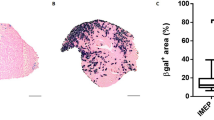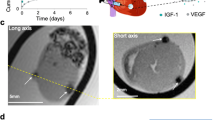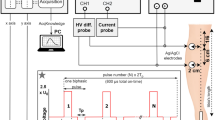Abstract
In vivo gene electrotransfer (ET) is a simple method of gene delivery in various tissues relying on the injection of plasmid DNA followed by application of electric pulses. Noninvasive tools are needed to evaluate the ET efficiency and the resulting tissue damages. In this study, we performed ET of rat tibialis muscle after injection of either a plasmid coding for luciferase or a contrast agent (CA) detected by using magnetic resonance imaging (MRI). Plasmid expression and CA intracellular trapped quantity were compared throughout the electric field intensity range 0–300 V/cm. Although the CA trapped quantity reflects only the electropermeabilization step, both measurements were correlated. MRI measurements gave easy access to tridimensional visualization of the labelled zones where the CA has been injected and the applied electric field had a value allowing permeabilization. We also performed MRI measurements of the water transverse relaxation time T2 as an indicator of tissue modification, and tested whether another CA specific for necrosis could be used to detect muscle necrosis at high electric field intensity. In conclusion, MRI measurements may bring multiparametric information upon the efficiency and tissue toxicity of an ET protocol by using a simple and safe CA.
This is a preview of subscription content, access via your institution
Access options
Subscribe to this journal
Receive 12 print issues and online access
$259.00 per year
only $21.58 per issue
Buy this article
- Purchase on Springer Link
- Instant access to full article PDF
Prices may be subject to local taxes which are calculated during checkout








Similar content being viewed by others
References
Bloquel C, Fabre E, Bureau MF, Scherman D . Plasmid DNA electrotransfer for intracellular and secreted proteins expression: new methodological developments and applications. J Gene Med 2004; 6 (Suppl 1): S11–S23.
Rizzuto G et al. Gene electrotransfer results in a high-level transduction of rat skeletal muscle and corrects anemia of renal failure. Hum Gene Ther 2000; 11: 1891–1900.
Bloquel C et al. Gene therapy of collagen-induced arthritis by electrotransfer of human tumor necrosis factor-alpha soluble receptor I variants. Hum Gene Ther 2004; 15: 189–201.
Silvestre JS et al. Antiangiogenic effect of interleukin-10 in ischemia-induced angiogenesis in mice hindlimb. Circ Res 2000; 87: 448–452.
Watanabe K et al. Protection against autoimmune myocarditis by gene transfer of interleukin-10 by electroporation. Circulation 2001; 104: 1098–1100.
Rols MP et al. In vivo electrically mediated protein and gene transfer in murine melanoma. Nat Biotechnol 1998; 16: 168–171.
Gehl J . Electroporation: theory and methods, perspectives for drug delivery, gene therapy and research. Acta Physiol Scand 2003; 177: 437–447.
Vilquin JT et al. Electrotransfer of naked DNA in the skeletal muscles of animal models of muscular dystrophies. Gene Therapy 2001; 8: 1097–1107.
Widera G et al. Increased DNA vaccine delivery and immunogenicity by electroporation in vivo. J Immunol 2000; 164: 4635–4640.
Mir LM . Therapeutic perspectives of in vivo cell electropermeabilization. Bioelectrochemistry 2001; 53: 1–10.
Mir LM et al. High-efficiency gene transfer into skeletal muscle mediated by electric pulses. Proc Natl Acad Sci USA 1999; 96: 4262–4267.
Aihara H, Miyazaki J . Gene transfer into muscle by electroporation in vivo. Nat Biotechnol 1998; 16: 867–870.
Mathiesen I . Electropermeabilization of skeletal muscle enhances gene transfer in vivo. Gene Therapy 1999; 6: 508–514.
Vicat JM et al. Muscle transfection by electroporation with high-voltage and short-pulse currents provides high-level and long-lasting gene expression. Hum Gene Ther 2000; 11: 909–916.
Durieux AC, Bonnefoy R, Manissolle C, Freyssenet D . High-efficiency gene electrotransfer into skeletal muscle: description and physiological applicability of a new pulse generator. Biochem Biophys Res Commun 2002; 296: 443–450.
Umeda Y et al. Skeletal muscle targeting in vivo electroporation-mediated HGF gene therapy of bleomycin-induced pulmonary fibrosis in mice. Lab Invest 2004; 84: 836–844.
Payen E et al. Improvement of mouse beta-thalassemia by electrotransfer of erythropoietin cDNA. Exp Hematol 2001; 29: 295–300.
Gehl J et al. In vivo electroporation of skeletal muscle: threshold, efficacy and relation to electric field distribution. Biochim Biophys Acta 1999; 1428: 233–240.
Mir LM, Banoun H, Paoletti C . Introduction of definite amounts of nonpermeant molecules into living cells after electropermeabilization: direct access to the cytosol. Exp Cell Res 1988; 175: 15–25.
Hartikka J et al. Electroporation-facilitated delivery of plasmid DNA in skeletal muscle: plasmid dependence of muscle damage and effect of poloxamer 188. Mol Ther 2001; 4: 407–415.
Paturneau-Jouas M et al. Electrotransfer at MR imaging: tool for optimization of gene transfer protocols – feasibility study in mice. Radiology 2003; 228: 768–775.
Rinck P . Magnetic Resonance in Medicine: The Basic Textbook of the European Magnetic Resonance Forum, 4th edn. Blackwell Science: Berlin, Germany, 2001.
Wishnia A, Alameddine H, Tardif de Gery S, Leroy-Willig A . Use of magnetic resonance imaging for noninvasive characterization and follow-up of an experimental injury to normal mouse muscles. Neuromuscul Disord 2001; 11: 50–55.
Ni Y et al. Magnetic resonance imaging-histomorphologic correlation studies on paramagnetic metalloporphyrins in rat models of necrosis. Invest Radiol 1997; 32: 770–779.
Mathur-de-Vré R, Lemort M . Biophysical properties and clinical applications of magnetic resonance imaging contrast agents. Br J Radiol 1995; 68: 225–247.
Rozijn TH et al. Determination of in vivo rat muscle Gd-DTPA relaxivity at 6.3 T. Magma 1999; 9: 65–71.
Crich S et al. Relaxation efficiency of cell internalized Gd-HPDO3A. ESMRMB 21th Annual Meeting, Copenhagen, September 8–12, 2004, p S222.
Gehl J, Mir LM . Determination of optimal parameters for in vivo gene transfer by electroporation, using a rapid in vivo test for cell permeabilization. Biochem Biophys Res Commun 1999; 261: 377–380.
Paturneau-Jouas M et al. Electroporation-mediated delivery of a magnetic resonance imaging contrast agent into muscle to visualize electrotransfer. Acta Myologica 2001; 20: 174–178.
Van Donkelaar CC et al. Diffusion tensor imaging in biomechanical studies of skeletal muscle function. J Anat 1999; 194: 79–88.
Wishnia A, Alameddine H, Tardif de Géry S, Leroy-Willig A . Use of magnetic resonance imaging for noninvasive characterisation and follow-up of experimental injury to normal mouse muscle. Neuromusc Disord 2001; 11: 50–55.
Ferret E, Evrard C, Foucal A, Gervais P . Volume changes of isolated human K562 leukemia cells induced by electric field pulses. Biotechnol Bioeng 2000; 67: 520–528.
Bureau MF et al. Importance of association between permeabilization and electrophoretic forces for intramuscular DNA electrotransfer. Biochim Biophys Acta 2000; 1474: 353–359.
Allamand V et al. Early adenovirus-mediated gene transfer effectively prevents muscular dystrophy in alpha-sarcoglycan-deficient mice. Gene Therapy 2000; 7: 1385–1391.
Palasz A, Czekaj P . Toxicological and cytophysiological aspects of lanthanides action. Acta Biochim Pol 2000; 47: 1107–1114.
Crich SG et al. Improved route for the visualization of stem cells labeled with a Gd-/Eu-chelate as dual (MRI and fluorescence) agent. Magn Reson Med 2004; 51: 938–944.
Bell JD, Taylor-Robinson SD . Assessing gene expression in vivo: magnetic resonance imaging and spectroscopy. Gene Therapy 2000; 7: 1259–1264.
Soubrier F et al. pCOR: a new design of plasmid vectors for nonviral gene therapy. Gene Therapy 1999; 6: 1482–1488.
Brasch RC . Rationale and applications for macromolecular Gd-based contrast agents. Magn Reson Med 1991; 22: 282–287.
Acknowledgements
This work was funded by a grant of the Association Française contre les Myopathies. We thank Dr JM Caillaud (Biodoxis, Paris, France) for performing the histological analysis.
Author information
Authors and Affiliations
Appendix I: Quantification of the CA trapped quantity
Appendix I: Quantification of the CA trapped quantity
In normal untreated muscle, the mean muscle signal intensity in the absence of Gd-DOTA trapped quantity depends on the muscle water relaxation times T1o and T2o and on time intervals in the measurement sequence, TR and TE,22 according to:

where T1o, T2o are respectively the longitudinal and transverse relaxation times of muscle water, and So is the asymptotic value of signal at very long value of time TR and very short value of time TE, reflecting tissue water content. Sm (mean value of signal in untreated muscle) is measured in the reference untreated ROI of the slice of interest.
The increased signal intensity in the labelled muscle ROI with CA concentration C is Si. Signal increase is related to the shortening of longitudinal relaxation time, with actual value T1, by

T1 shortening is related to the tissue CA concentration C by 1/T1=1/T1o+KC, where K is the relaxivity of the CA.
T2 shortening induced by the CA, calculated from a similar equation, is negligible, with variation under 1 ms in the range of Gd-DOTA concentration for these experiments.
The relation between signal and local concentration is based upon an estimation of Gd-DOTA relaxivity in muscle cells. We assume the relaxivity of Gd-DOTA K to be 2.7/s/mM, deduced from Gd-DOTA relaxivity in water, and from experimental data obtained by Rozijn et al26 in rat muscle and in water solution, for the similar agent Gd-DTPA. The signal intensity is determined experimentally in water from a phantom with calibrated concentrations of Gd-DOTA, in acquisition conditions identical to those used in vivo. From the measurements obtained in the water phantom and from muscle relaxation times, the equation linking the signal increase R=(Si−Sm)/Sm to the concentration of Gd-DOTA C is

We here assume that So is not modified, and that the influence of T2 variation can be neglected since TE value is short. This is an acceptable approximation at value of electric field under 200 V/cm where T2 and T1 variations induced by oedema are weak. At higher electric field, the reference region is taken in a neighbouring muscle, also submitted to ET but not to injection, so that T2 variations linked to oedema do not interfere with determination of C. In case of increased T2, overestimation of C and then of Q would follow from this approximation.
Rights and permissions
About this article
Cite this article
Leroy-Willig, A., Bureau, M., Scherman, D. et al. In vivo NMR imaging evaluation of efficiency and toxicity of gene electrotransfer in rat muscle. Gene Ther 12, 1434–1443 (2005). https://doi.org/10.1038/sj.gt.3302541
Received:
Accepted:
Published:
Issue Date:
DOI: https://doi.org/10.1038/sj.gt.3302541
Keywords
This article is cited by
-
The influence of skeletal muscle anisotropy on electroporation: in vivo study and numerical modeling
Medical & Biological Engineering & Computing (2010)
-
Analytical and numerical quantification and comparison of the local electric field in the tissue for different electrode configurations
BioMedical Engineering OnLine (2007)
-
Gene therapy progress and prospects: Duchenne muscular dystrophy
Gene Therapy (2006)



